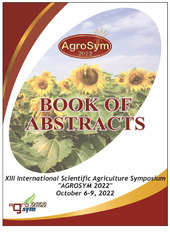Приказ основних података о документу
Bioinoculants in sustainable agriculture – the influence on maize characteristics and phytobiome
| dc.creator | Dimkić, Ivica | |
| dc.creator | Jelušić, Aleksandra | |
| dc.creator | Hladnik, Matjaž | |
| dc.creator | Janakiev, Tamara | |
| dc.creator | Bandelj, Dunja | |
| dc.creator | Vukićević, Slavoljub | |
| dc.creator | Fira, Đorđe | |
| dc.date.accessioned | 2023-08-07T10:39:08Z | |
| dc.date.available | 2023-08-07T10:39:08Z | |
| dc.date.issued | 2022 | |
| dc.identifier.isbn | 978-99976-987-2-8 | |
| dc.identifier.uri | http://rimsi.imsi.bg.ac.rs/handle/123456789/2041 | |
| dc.description.abstract | Maize (Zea mays L.) occupies a significant part of the world cultivated area. Beneficial microorganisms and organic fertilizers are powerful tools for sustainable agricultural management. Applying appropriate formulation either through seed coating or composting material together with seeds during the sowing was aimed to achieve optimal performance on plants and increase the crop yields. Also, a complete analysis of phytobiome including high-throughput amplicon and whole-genome sequencing, and computational biology of the treated and non-treated plants' roots and soil was applied. The statistically significant difference in bacterial communities between phenophases and treatments was much more prevalent in the roots than soil itself. In general, seedling phenophase (II) differed in terms of diversity from bacterial communities of flowering (III) and harvesting phenophases (IV), regardless of treatment, indicating good colonization with the treated substrate for up to one month. In the root samples, the dominance of the genus Pseudomonas was evident, in the initial stages (phase II), while this percentage decreased linearly over time. High relative abundance of the genera Achromobacter, Sphingobacterium, and Stenotrophomonas also characterized II phenophase. Contrary, a relative abundance of the genus Bacillus was characteristic for III phenophase, and especially twice or three times higher in treatments with phytobiotic or manure compared to the negative control. Furthermore, it was observed that with increasing inoculation of Bacillus isolate, the percentage of Pantoea genus decreases drastically in coated seeds. In conclusion, a statistically significant increase in maize yield was obtained in the treatment with phytobiotic with an average value of 650 kg/ha compared to the negative control. | sr |
| dc.language.iso | en | sr |
| dc.publisher | Istočno Sarajevo : Poljoprivredni fakultet | sr |
| dc.rights | openAccess | sr |
| dc.source | XIII International Scientific Agriculture Symposium "AGROSYM 2022", Jahorina, Bosnia and Herzegovina | sr |
| dc.subject | Maize | sr |
| dc.subject | Phytobiotic | sr |
| dc.subject | Poultry manure | sr |
| dc.subject | Next Generation Sequencing | sr |
| dc.subject | Phytobiome | sr |
| dc.title | Bioinoculants in sustainable agriculture – the influence on maize characteristics and phytobiome | sr |
| dc.type | conferenceObject | sr |
| dc.rights.license | ARR | sr |
| dc.citation.epage | 348 | |
| dc.citation.spage | 348 | |
| dc.identifier.fulltext | http://rimsi.imsi.bg.ac.rs/bitstream/id/5373/bitstream_5373.pdf | |
| dc.identifier.rcub | https://hdl.handle.net/21.15107/rcub_rimsi_2041 | |
| dc.type.version | publishedVersion | sr |

